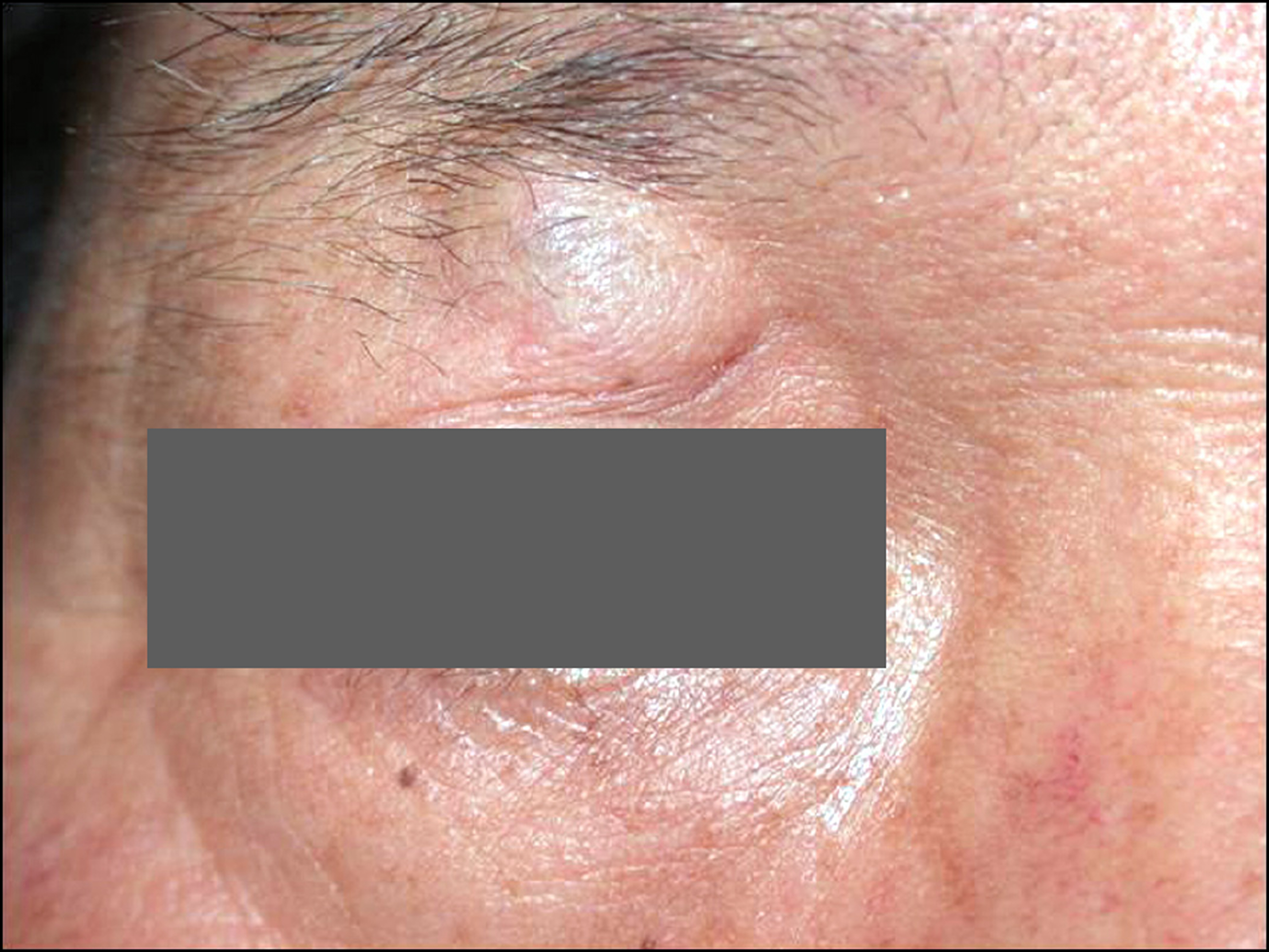J Korean Ophthalmol Soc.
2013 Jun;54(6):962-965. 10.3341/jkos.2013.54.6.962.
A Case of Idiopathic Orbital Sudoriferous Cyst in an Adult
- Affiliations
-
- 1Department of Ophthalmology, Chonbuk National University Medical School, Research Institute of Clinical Medicine of Chonbuk National University-Biomedical Research Institute of Chonbuk National University Hospital, Jeonju, Korea. ahnmin@jbnu.ac.kr
- KMID: 2217275
- DOI: http://doi.org/10.3341/jkos.2013.54.6.962
Abstract
- PURPOSE
To report a rare case of an idiopathic sudoriferous cyst involving the orbit in an adult.
CASE SUMMARY
A 52-year-old male visited our clinic with an orbital mass in the right eye, which had developed 4 months prior to admission. A 2 x 1.5 cm-sized hard orbital mass was palpated in the middle area of the right upper orbit. On sonographic imaging, a well-demarcated tumor was identified that showed no echogenicity. We performed anterior orbitotomy with a lid crease incision. The tumor was completely removed. Histopathological examination showed a solitary cyst lined with two or three layers of cuboidal epithelial cells with scattered goblet cells. The tumor was classified as a sudoriferous cyst.
CONCLUSIONS
Sudoriferous cyst should be considered in the differential diagnosis of a well-circumscribed mass lesion involving the orbit in adult patients.
Keyword
Figure
Reference
-
References
1. Wiliam HS. Eyelids and Lacrimal Drainage System. In: Jurij RB, ed. Ophthalmic Pathology. 4th ed.Philadelphia: WB Saunders;1996; v. 4:chap. 11.2. Haider E, Saigal G, Gill D. . Congenital orbital sudoriferous cyst: radiological findings. Pediatr Radiol. 2005; 35:1142–4.
Article3. Kim JY, Lee EK, Lee YH, Lee SB. Apocrine sudoriferous cyst in medial canthal region occurred after trauma. J Korean Ophthalmol Soc. 2007; 48:1562–6.
Article4. Smith RJ, Kuo IC, Reviglio VE. Multiple apocrine hidrocystomas of the eyelids. Orbit. 2012; 31:140–2.
Article5. Mehta A, Rao A, Khanna A. Sudoriferous cyst of the orbit of adult origin after trauma. Indian J Ophthalmol. 2008; 56:235–7.
Article6. Chung JK, Lee SJ, Kang SK, Park SH. Congenital sudoriferous cyst within the orbit followed by esotropia. Korean J Ophthalmol. 2007; 21:120–3.
Article7. Rosen WJ, Li Y. Sudoriferous cyst of the orbit. Ophthal Plast Reconstr Surg. 2001; 17:73–5.
Article8. Valenzuela AA, Heathcote JG. Apocrine hidrocystoma of the orbit. Orbit. 2011; 30:316–7.
Article9. Saunders JF. Congenital sudoriferous cyst of the orbit. Arch Ophthalmol. 1973; 89:205–6.
Article10. Park SJ, Jang JW, Chin HS. Sudoriferous cyst of the orbit. J Korean Ophthalmol Soc. 1998; 39:1288–90.11. Mims J, Rodrigues M, Calhoun J. Sudoriferous cyst of the orbit. Can J Ophthalmol. 1977; 12:155–6.12. Vignes JR, Franco-Vidal V, Eimer S, Liguoro D. Intraorbital apoc-rine hidrocystoma. Clin Neurol Neurosurg. 2007; 109:631–3.
Article13. Shields JA, Shields CL. Orbital cysts of childhood–classification, clinical features, and management. Surv Ophthalmol. 2004; 49:281–99.
Article
- Full Text Links
- Actions
-
Cited
- CITED
-
- Close
- Share
- Similar articles
-
- Sudoriferous Cyst of the Orbit
- Apocrine Sudoriferous Cyst in Medial Canthal Region Occurred after Trauma
- Congenital Sudoriferous Cyst within the Orbit Followed by Esotropia
- Sudoriferous Cyst Adhered to Levator Aponeurosis: A Case Report
- A Case of Idiopathic Orbital Myositis Involving All Extraocular Muscles of Both Eyes




